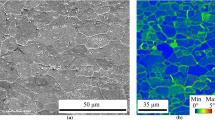Abstract
Tensile behavior of BH220 steel with different pre-strain conditions (2 and 8%) followed by bake hardening was studied at different strain rates (0.001 and 0.1/s). Dislocation densities of the deformed specimens were successfully estimated from x-ray diffraction profile analysis using the modified Williamson-Hall equation. The results indicate that other than 2% pre-strain the dislocation density increases with increase in pre-strain level as well as with strain rate. The decrease in the dislocation density in 2% pre-strain condition without any drop in strength value is attributed to the characteristic dislocation feature formed during pre-straining.






Similar content being viewed by others
References
G. Davies, Materials for Automobile Bodies, Elsevier, London, 2012, p 93–143
E. Pereloma, H. Beladi, L. Zhang, and I. Timokhina, Understanding the Behavior of Advanced High-Strength Steels Using Atom Probe Tomography, Metall. Mater. Trans. A, 2012, 43, p 3958–3971
L.J. Baker, S.R. Daniel, and J.D. Parker, Metallurgy and Processing of Ultralow Carbon Bake Hardening Steels, Mater. Sci. Technol., 2002, 18, p 355–367
W.C. Leslie, The Physical Metallurgy of Steels, McGraw Hill Book Company, New York, 1981, p 41–42
L.J. Baker, S.R. Daniel, and J.D. Parker, Mechanism of Bake Hardening in Ultralow Carbon Steel Containing Niobium and Titanium Additions, Mater. Sci. Technol., 2002, 18, p 541–547
G. Gottstein, Physical Foundations of Materials Science, Springer, USA, 2004, p 245–251
G. Mukhopadhyay, S. Bhattacharya, and K.K. Ray, Effect of Pre-strain on the Strength of Spot-Welds, Mater. Des., 2009, 30, p 2345–2354
G. Mukhopadhyay, S. Bhattacharya, and K.K. Ray, Strength Assessment of Spot-Welded Sheets of Interstitial Free Steels, J. Mater. Process. Technol., 2009, 209, p 1995–2007
S. Berbenni, V. Favier, X. Lemoine, and M. Berveiller, A Micromechanical Approach to Model the Bake Hardening Effect for Low Carbon Steels, Scripta Mater., 2004, 51, p 303–308
R.W. Cahn and P. Haasen, Physical Metallurgy, Vol 2, North-Holland Publishing Company, Netherlands, 1996, p 1062–1133
S. Graca, R. Colaco, P.A. Carvalho, and R. Vilar, Determination of Dislocation Density from Hardness Measurements in Metals, Mater. Lett., 2008, 62, p 3812–3814
R. Kishor, L. Sahu, K. Dutta, and A.K. Mondal, Assessment of Dislocation Density in Asymmetrically Cyclic Loaded non-conventional Stainless Steel Using X-ray Diffraction Profile, Mater. Sci. Eng. A, 2014, 598, p 299–303
Standard test method for tension testing of metallic materials (Metric), E8M-13, Annual Book of ASTM Standards, ASTM, 2013, p. 1–28
T. Ungar, J. Gubicza, P. Hanak, and I. Alexandrov, Densities and Character of Dislocations and Size-Distribution of Subgrains in Deformed Metals by X-ray Diffraction Profile Analysis, Mater. Sci. Eng. A, 2001, 319–321, p 274–278
R.A. Renzetti, H.R.Z. Sandim, R.E. Bolmaro, P.A. Suzuki, and A. Moslang, X-ray Evaluation of Dislocation Density in ODS-Eurofer Steel, Mater. Sci. Eng. A, 2012, 534, p 142–146
G.E. Dieter, Mechanical Metallurgy, McGraw-Hill Book Company, Singapore, 1987, p 287
M.N. Bassim and M.R. Bayoumi, The Observation of Dislocation Structures During the Fracture of Prestrained AISI, 4340 Steel, Mater. Sci. Eng., 1986, 81, p 317–324
Q.Z. Chen and B.J. Duggan, On Cells and Microbands Formed in an Interstitial-Free Steel During Cold Rolling at Low to Medium Reductions, Metall. Mater. Trans. A, 2004, 35, p 3423–3430
T. Ungar, I. Dragomir, A. Revesz, and A. Borbely, The Contrast Factors of Dislocations in Cubic Crystals: The Dislocation Model of Strain Anisotropy in Practice, J. Appl. Cryst., 1999, 32, p 992–1002
S. Majumdar and K.K. Ray, Effect of Pre-strain on the Ductile Fracture Behaviour of an Interstitial Free Steel, Metall. Mater. Trans. A, 2006, 37, p 3541–3553
S. Sivaprasad, S. Tarafder, V.R. Ranganath, and K.K. Ray, Effect of Prestrain on Fracture Toughness of HSLA Steels, Mater. Sci. Eng. A, 2000, 284, p 195–201
M.N. Bassim, Mathematical Prediction of Dislocation Cell Sizes with Strain Using the Mesh-Length Theory of Work Hardening, Mater. Sci. Eng. A, 1989, 113, p 367–371
Author information
Authors and Affiliations
Corresponding author
Rights and permissions
About this article
Cite this article
Seth, P.P., Das, A., Bar, H.N. et al. Evolution of Dislocation Density During Tensile Deformation of BH220 Steel at Different Pre-strain Conditions. J. of Materi Eng and Perform 24, 2779–2783 (2015). https://doi.org/10.1007/s11665-015-1554-6
Received:
Revised:
Published:
Issue Date:
DOI: https://doi.org/10.1007/s11665-015-1554-6




